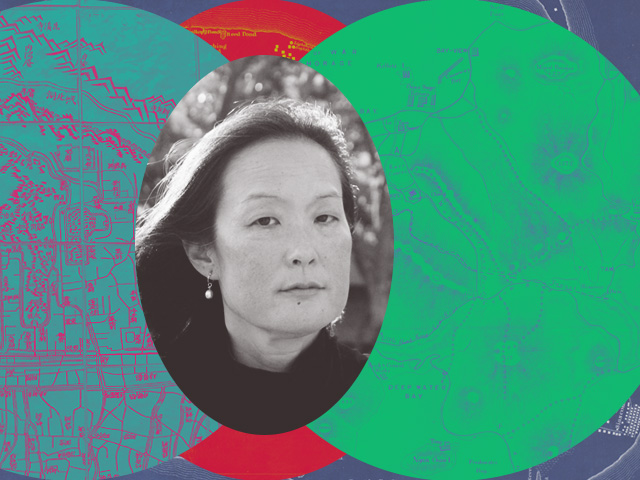The award-winning writer talks about her new acclaimed short story collection, the anxiety of exile, and figuring out which narrative you belong to.

April 26, 2017
Stephanie Han’s award-winning Swimming in Hong Kong is a polycultural, trans-oceanic collection of stories that moves fluidly from Nantucket Island to Seoul to Hong Kong’s Central District. Han’s characters are memorable—an African-American architect who must brave the tyranny of Hong Kong; a white American in Korea who grapples with language of the heart; and a Korean-American woman who struggles to figure out the territorial rights to her body, among others. Han uses the sharpest of forensic tools to show characters falling in love, questioning faith, and exploring sexual and political loyalties. The winner of this year’s Paterson Fiction Prize, Swimming in Hong Kong calls into question our own personal myths about home, desire, and belonging.
Han is a fourth generation Korean American who spent her childhood crisscrossing the United States and Korea. She later returned to live in Asia as an expatriate. Her collection reflects a 21st-century global aesthetic that I identify with as a third culture immigrant.
Gail Vida Hamburg: You have labored over this story collection for a long time. Could you talk about its genesis and evolution?
Stephanie Han: I began writing the collection in 1997, after returning from an 18-month sojourn in Korea—studying at a Korean language institute, freelance writing, and working on my then novel. After I came back to California, I wrote The Body Politic, 1982. The early stories, set in Korea and the United States, explored questions and issues surrounding Korean migration and immigration to the U.S. However, my perspective and the nature of the collection changed significantly after I lived in Hong Kong. I wrote a few of the stories over a six- to seven-year period, during which they were shelved, rewritten, rejected, revised. I know some writers do have agents or editors who tell them how to rewrite or suggest ways to revise. But I didn’t have that kind of support. It was just me. The collection made the rounds unsuccessfully in 2007, at which point I was dropped by my agent and I moved to Hong Kong. The very last thing I did was to give dates to some of the stories. There were questions from the past that continue to be questions today—what is the nature of friendship, how do people cross cultural boundaries, what are the expectations within ethnic groups about issues like feminism and so on.
You submitted those stories and received many rejections. What made you keep going?
Each story was rejected easily over a hundred times, with only one or two exceptions. I kept revising because I got enough encouragement along the way that I felt I was on the right path. I didn’t know it at the time but I think part of the difficulty was that the stories were about conversations that we’re now having in 2016—about globalization, about the nature of feminism, and cross-cultural situations that people didn’t expect. The kinds of questions that the stories provoke have always been there, and have been asked by people who circulate on a global level or have an understanding of global migration. But these questions are now mainstream questions and I think this is what allowed the book to finally be published. I guess I am also really stubborn. There was a time when I thought I’d chuck the whole thing. If I could have found something else to do, I probably would have quit writing. It’s insane when I think of my thousands of rejections over the years, and not just for these stories. Writing is not really a matter of choice because there is no rational way to explain why I would continue.
Your stories are about people who live between cultures or are outsiders in a culture. Could you talk about your own biography and how that has affected your writing?
Asian Americans have always been perceived as being outside of the mainstream of American culture, even within the context of the broader population of people of color. This has to do with numbers; it has to do with the nature of how Asian Americans came to occupy a spot within the continental U.S. (and extra-continental U.S., if you consider Hawaii, where I now make my home). We occupy a peculiar position because we don’t have a single binding narrative. So this idea of Asian American is really something that is distinctly American in nature, this idea that we can share things and move beyond the boundaries that might have existed in Asia. This is quite unique in America, so I think in that sense, I’m familiar with the idea of people who live between and outside cultures. My father was in the military while I was growing up and we moved constantly and then I lived overseas. If you’re a person who’s moved a lot, this idea of living between cultures, outside of cultures even, is normal.
The book was written over a period when there were shifts taking place in the culture about some of the issues you write about. The date rape story comes to mind. There’s also an exilic and racial anxiety to the character in that story, which I would venture would be less familiar to those who have fully assimilated or acculturated into a host milieu. Would you agree with that?
Yes, I do think there’s a degree of racial and exilic anxiety that is part of the coming-of-age process for many young people of color, particularly young women in the U.S., who have this anxiety about how one negotiates feminism, how one negotiates one’s place as a woman within the context of one’s political or cultural community and also within the extended context of the U.S., and even within the globe now.
Certain questions—of femininity, of feminism, of where we fit in, and what group we belong to—are or can be more severe in the U.S. This is perhaps because of the way people organize here under a multitude of groups and banners. There are a lot of different American narratives and we have to figure out which one we belong to, that we want to contribute to, or that we want to author ourselves.
Were you aware that you were writing a book with an eye on the future?
No, I was not! I thought the book would be published earlier; it was ready in 2005. But when the stories kept getting rejected, I began looking at them critically to figure out why. I think a lot of publications could not fathom the multitude of experiences that people of color can have. I was simply writing stories about what I observed and what I thought—I didn’t know that I was writing a futuristic book at all. I wrote literary realism, but I know now how genre can trouble audience expectations. If you’ve never seen it, how can it be real?
Your stories are populated by immigrants, expatriates, and native misfits. How are they different in their experiences of dislocation and dis-ease? How are they the same?
These people are actually quite different—the categories of people who are migrants versus refugees, or an indigenous person to a particular land or a misfit. These people are very different because they are treated differently by the state and we are now organized under a state rubric. If you can understand what it means to migrate, what it means to move, whether it is being forced out of your home, or being obliged to communicate in a different language, or being put in unfamiliar situations, you gain a different perspective. At the very least you gain an inkling of something.
You’ve lived in Hong Kong as a Korean American married to a Brit. Your story “Invisible,” about an interracial married couple, is so loaded with class and race and color consciousness and the unspoken but fully embedded social hierarchy of Hong Kong. How would you describe Hong Kong, both as an artist with a broad brushstroke and as a pointillist and miniaturist?
My experience of Hong Kong is that of being an outsider, a witness. Hong Kong is a center of commerce and a financial capital. There are many people from all over China who come to Hong Kong seeking an idea of reinvention, wanting to make money, and wanting to participate in the narrative of Hong Kong. What interests me about Hong Kong is how the diverse population interacts. There’s a large Nepalese population because of the Gurkhas who came with the British, many South Asians, and Chinese from everywhere. These people have to exchange and communicate, usually to improve their financial status., but there are also moments of exchange where there’s this light, and they’re dealing with people different from themselves, and they want to be reminded of their humanity.
You are, to me, all-American in all the ways that count. And yet you are also a rarefied hothouse orchid in so many ways: a Californian, a Korean American, a Hawaiian, with a Midwestern childhood. What has that done to you as a writer? What are you acutely sensitive to?
I’m acutely sensitive to geography, and to movement and place and travel. Every place that I have lived has shaped and changed the way that I look and construct my universe. I have also come to respect that it takes living in a place to understand it, and there are always unknown elements, but that’s okay. Place and narrative inform all of my writing, even my poetry.

Excerpt from “The Invisible”
This is how to become invisible in Hong Kong. Ideally you should look Han Chinese, which is to have fair skin with dark hair and flat high cheekbones. You should be attractive, but not so much that you gain attention in any unusual way, but attractive enough to pass the scrutiny of the doorman of the club that you and your tall, light, green-eyed husband have belonged to for the past three months. You should be able to smile and flash your membership card and pull open the brass handles of the door without being stopped.
You are not a gweilo, a foreign devil, or a ghost person, a term of insult, but a foreigner of another kind. Your complexion is not olive, a sign to the doorman that you could be Filipina, which in most places in this city guarantees a disparaging glance, harsh words from the locals, and a lascivious glance if you are younger, by Western men who are twice your age or at least twice your body weight. You aren’t Han Chinese; you are Korean.
You are seen as belonging to the local Chinese if your husband is absent and you are silent, and to the expatriates only if you are on his arm — your husband called either more or less of a man because he is with you.
This establishment is in the grand tradition of colonial clubs, yet with modern considerations. It’s open to locals of a certain privilege and distinction who circulate in the company of foreigners, locals who move seamlessly from one society to the next, occupy important posts, possess substantial holdings, educate their children in the West, and who, along with their former colonial overlords, now agree with everything Beijing has to say; before everyone agreed with everything London had to say, as to agree is to be rich, which is to be glorious. It is a marvelous circle, the elite of one nation admiring and mimicking the elite of another, the mutual goal of keeping the underlings out, whatever their pigmentation, cementing the tacit bond of wealth.



